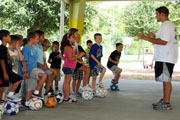Want to become a more powerful athlete? Whether you want to jump higher or throw farther, plyometric workouts will help you accomplish that!
What are Plyometrics?
Plyometrics are exercises designed to produce fast and powerful movements from your body. These exercises benefit your fast-twitch muscles, which are the muscles responsible for jumping, sprinting and throwing. In other words, plyometric workouts enable a muscle to reach the maximum force in the shortest possible time.Exercises
Plyometric training conditions the body through resistance excersises. Depending on what you are trying to accomplish, there is a specialized plyometric program. If you are trying to jump higher, you can do box-jumping drills. Hoping off and on the box as quickly as possible. Twice a week, you would do three sets of ten jumps with three minutes breaks in between. This is just one example of a lower body plyometric exercise - there are many others you would do in a workout.
If you are trying to have a stronger upper body so you can thrown farther or faster, a good plyometric workout is using a medicine ball, which is a bouncy and heavier ball. You would do a set of 10 chest passes back and forth with a partner. You would also do two sets of this with four-minute breaks in between. You would do this drill twice a week.
Benefits
Plyometrics give an athlete benefits that cardio workouts or general weight training cannot. You will focus on the muscles that will make you faster and more powerful. Regular participation in plyometric training can also help strengthen your bone structure and maintain a healthy weight. Plyometrics can also prevent injuries like ACL tears or ankle injuries. The results of plyometrics not only improve strength and power, but also improve skill and performance.Safety
Like weight training, plyometrics for kids and teenagers can be dangerous and can result in injury. Make sure you consult with a strength-training coach and doctor before you try any plyometric drill. Also start off slow, you should be in a certain physical condition before you can do some of the more advanced drills. Doing plyometrics can also be very hard on the body. It is important that you give your muscles two to three days of rest so they can recover.Related Stories:






























